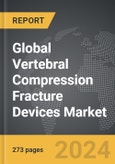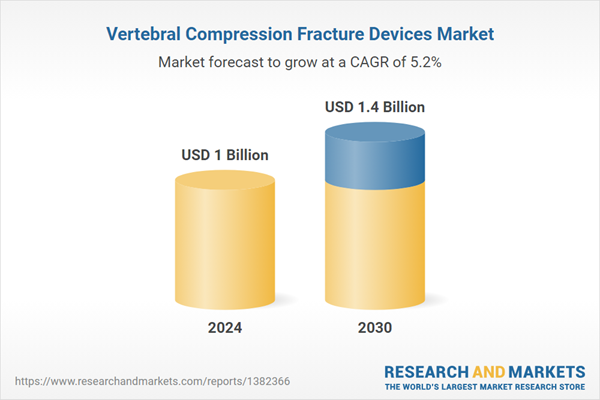Vertebral Compression Fracture Devices - Key Trends and Drivers
Vertebral compression fracture (VCF) devices are essential tools in the management and treatment of spinal fractures, particularly those resulting from osteoporosis, trauma, or metastatic disease. These fractures occur when the vertebral body in the spine collapses, leading to severe pain, reduced mobility, and potential deformity of the spine. The primary aim of VCF devices is to stabilize the fracture, alleviate pain, and restore the vertebral height and function to as close to normal as possible. The most commonly used VCF devices include vertebroplasty and kyphoplasty kits. Vertebroplasty involves the injection of bone cement into the fractured vertebra to stabilize it, whereas kyphoplasty includes the additional step of inflating a balloon inside the vertebra to create a cavity before cement injection, which helps in restoring some of the lost vertebral height. These minimally invasive procedures have become increasingly popular due to their ability to provide immediate pain relief and improve patient outcomes with shorter recovery times compared to traditional surgical methods, making them an attractive option for both patients and healthcare providers.The application of VCF devices spans a diverse patient demographic, from the elderly suffering from osteoporosis to younger individuals with traumatic spinal injuries or cancer-related bone weakening. The rising incidence of osteoporosis, particularly among the aging population, is a significant driver of the demand for VCF treatments. As the population ages, the prevalence of conditions that contribute to bone weakening, such as osteoporosis, continues to rise, increasing the need for effective treatment options. Advancements in imaging technologies, such as magnetic resonance imaging (MRI) and computed tomography (CT) scans, have greatly improved the diagnosis and management of vertebral fractures, allowing for more precise and effective interventions. The integration of advanced biomaterials in bone cement and the development of new delivery systems have further enhanced the safety and efficacy of these procedures. Moreover, the increasing awareness of the benefits of early intervention in vertebral fractures has led to a higher adoption rate of VCF devices among healthcare providers. The introduction of navigational tools and robotics in spinal surgeries also holds significant promise for more precise placement of these devices, potentially improving outcomes and reducing the risk of complications associated with these procedures.
The growth in the vertebral compression fracture devices market is driven by several factors. Technological advancements have played a crucial role, with innovations in biomaterials and the development of more sophisticated delivery systems significantly enhancing the performance and safety of VCF procedures. These advancements have made the procedures more effective and accessible, thereby expanding their use. The increasing prevalence of osteoporosis and other conditions that weaken bones is expanding the addressable market for these devices, as more individuals require treatment for these debilitating fractures. Moreover, the aging global population, coupled with the consequent rise in age-related spinal conditions, serves as a significant driver of market demand. Healthcare providers are increasingly favoring minimally invasive procedures due to their associated benefits, such as reduced hospital stays, lower risk of infections, and quicker recovery times, which propel the adoption of VCF devices. Additionally, the improved diagnostic capabilities afforded by advanced imaging technologies have led to more timely and accurate treatments, enhancing patient outcomes. Favorable reimbursement policies for minimally invasive spine procedures and the development of cost-effective treatment options are also contributing to market growth. As these trends continue to evolve, the demand for vertebral compression fracture devices is expected to rise, fostering further innovation and development in the field, ensuring that patients have access to the most effective and advanced treatment options available.
Report Scope
The report analyzes the Vertebral Compression Fracture Devices market, presented in terms of units. The analysis covers the key segments and geographic regions outlined below.Segments: Product (Balloon Kyphoplasty, Vertebroplasty); Surgery (Minimally Invasive Spine Surgery, Open Spine Surgery).
Geographic Regions/Countries: World; United States; Canada; Japan; China; Europe (France; Germany; Italy; United Kingdom; Spain; Russia; and Rest of Europe); Asia-Pacific (Australia; India; South Korea; and Rest of Asia-Pacific); Latin America (Argentina; Brazil; Mexico; and Rest of Latin America); Middle East (Iran; Israel; Saudi Arabia; United Arab Emirates; and Rest of Middle East); and Africa.
Key Insights:
- Market Growth: Understand the significant growth trajectory of the Balloon Kyphoplasty segment, which is expected to reach US$1.2 Billion by 2030 with a CAGR of a 5.3%. The Vertebroplasty segment is also set to grow at 4.5% CAGR over the analysis period.
- Regional Analysis: Gain insights into the U.S. market, valued at $272.6 Million in 2024, and China, forecasted to grow at an impressive 8.6% CAGR to reach $304.1 Million by 2030. Discover growth trends in other key regions, including Japan, Canada, Germany, and the Asia-Pacific.
Why You Should Buy This Report:
- Detailed Market Analysis: Access a thorough analysis of the Global Vertebral Compression Fracture Devices Market, covering all major geographic regions and market segments.
- Competitive Insights: Get an overview of the competitive landscape, including the market presence of major players across different geographies.
- Future Trends and Drivers: Understand the key trends and drivers shaping the future of the Global Vertebral Compression Fracture Devices Market.
- Actionable Insights: Benefit from actionable insights that can help you identify new revenue opportunities and make strategic business decisions.
Key Questions Answered:
- How is the Global Vertebral Compression Fracture Devices Market expected to evolve by 2030?
- What are the main drivers and restraints affecting the market?
- Which market segments will grow the most over the forecast period?
- How will market shares for different regions and segments change by 2030?
- Who are the leading players in the market, and what are their prospects?
Report Features:
- Comprehensive Market Data: Independent analysis of annual sales and market forecasts in US$ Million from 2024 to 2030.
- In-Depth Regional Analysis: Detailed insights into key markets, including the U.S., China, Japan, Canada, Europe, Asia-Pacific, Latin America, Middle East, and Africa.
- Company Profiles: Coverage of players such as Alphatec Spine, Inc., Benvenue Medical, Inc., Globus Medical, Inc., Johnson & Johnson, Medtronic PLC and more.
- Complimentary Updates: Receive free report updates for one year to keep you informed of the latest market developments.
Some of the 14 companies featured in this Vertebral Compression Fracture Devices market report include:
- Alphatec Spine, Inc.
- Benvenue Medical, Inc.
- Globus Medical, Inc.
- Johnson & Johnson
- Medtronic PLC
- Stryker Corporation
- Vexim SA
- Zimmer Biomet Holdings, Inc.
Tariff Impact Analysis: Key Insights for 2025
Global tariff negotiations across 180+ countries are reshaping supply chains, costs, and competitiveness. This report reflects the latest developments as of April 2025 and incorporates forward-looking insights into the market outlook.The analysts continuously track trade developments worldwide, drawing insights from leading global economists and over 200 industry and policy institutions, including think tanks, trade organizations, and national economic advisory bodies. This intelligence is integrated into forecasting models to provide timely, data-driven analysis of emerging risks and opportunities.
What’s Included in This Edition:
- Tariff-adjusted market forecasts by region and segment
- Analysis of cost and supply chain implications by sourcing and trade exposure
- Strategic insights into geographic shifts
Buyers receive a free July 2025 update with:
- Finalized tariff impacts and new trade agreement effects
- Updated projections reflecting global sourcing and cost shifts
- Expanded country-specific coverage across the industry
Table of Contents
Companies Mentioned (Partial List)
A selection of companies mentioned in this report includes, but is not limited to:
- Alphatec Spine, Inc.
- Benvenue Medical, Inc.
- Globus Medical, Inc.
- Johnson & Johnson
- Medtronic PLC
- Stryker Corporation
- Vexim SA
- Zimmer Biomet Holdings, Inc.
Table Information
| Report Attribute | Details |
|---|---|
| No. of Pages | 273 |
| Published | April 2025 |
| Forecast Period | 2024 - 2030 |
| Estimated Market Value ( USD | $ 1 Billion |
| Forecasted Market Value ( USD | $ 1.4 Billion |
| Compound Annual Growth Rate | 5.2% |
| Regions Covered | Global |









